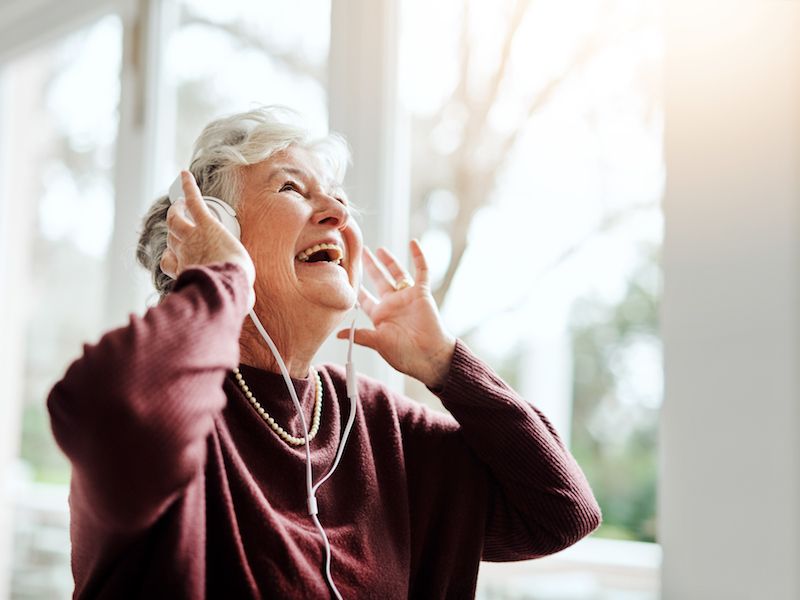
People who work in loud surroundings like construction sites or at heavy metal concerts are not the only ones impacted by noise related hearing loss. It doesn’t even have to be work-related, leisure-related noise exposure can be harmful, also. What kind of exposure are we talking about? Loud sounds heard through headphones, whether it’s gaming, streaming video, music, or even an audiobook with the volume turned up.
You may not believe your smartphone or tablet can get that loud. But these devices can reach sustained volumes of over 105 dB, which is around the ordinary human pain threshold. Your ears will actually start to hurt at this volume. So what’s the plan to protect against this kind of noise-related hearing loss?
It’s important here to think about the volume. Listen with the volume at no more than 60% for 60 minutes or less each session (how long you listen for also matters), this is known as the 60/60 rule.
Create a Setting on Your Hearing Aids For Music
Make certain, if you’re wearing hearing aids, you don’t attempt to drown out other noises by turning your streaming music up too loud. In addition, consult us about how to best listen to music. If you’re a musician or someone who loves music you may have recognized that most hearing aids are created to enhance the quality of voices…not necessarily music. We might be able to change the configuration to lessen noise and feedback while boosting some frequency ranges to better the quality of sound when listening to music.
How to Choose The Right Headphones
When getting headphones there are many options, particularly if you have hearing aids. There are a few things to consider, although it’s largely a matter of personal preference.
Headphones That go Over The Ears
Over the ear headphones are becoming popular again but you probably won’t find the old foam covered speakers that once came with a walkman. They have lots of choices in style and color, are usually endorsed by celebrities, and can be unexpectedly pricey. And unlike those little foam pads, these cover the entire ear, stopping outside sounds.
Main-stream wisdom is that these are less dangerous than in-ear headphones because the source of the sound is further from your eardrum. But the fact is they’re often capable of much louder volume than the smaller kind, the speakers are much larger. Noise cancellation can be a good thing as long as you’re not missing needed sounds such as an oncoming automobile. But on the upside, you won’t need to contend with outside noise so you can listen to your music at lower volumes.
Earbuds
The standard earbuds that come with devices such as iPhones are known for their inferior sound quality, although many people still use them because hey, they came with the phone. Plus, with newer devices that no longer have a headphone jack, sticking with Apple’s earbuds can simply be easier.
Earbuds also don’t block out noise so the downside is, you have a tendency to crank up the volume. It’s generally assumed that placing earbuds so close to your eardrum is the main issue but it’s really the volume.
Earbuds That Block Outside Sound
More comfortable than standard earbuds, models with a round rubber tip are the choice of many because they help stop outside sound. A seal that stops outside sound from getting in is formed by the rubber tip which molds to the shape of the ear. But these earbuds can also block out noises you need to hear and loud volume is still the main problem. Obviously, these won’t work for you if you have hearing aids.
A number of pairs may have to be tested before you find headphones that meet your requirements. Depending on what you’re most often using them for say talking on the phone, versus listening to music, you’ll have different acoustic expectations. The essential thing is to find headphones that make it comfortable for you to listen at a safe and secure volume.
How to Make Certain Your Hearing is Safeguarded
Is it Safe, How Can I be certain? If you have a smartphone, you can get an app for that, you can get the National Institute for Occupational Safety and Health’s free Sound Level Meter app. You can get different apps, but research has found that the reliability of these other apps is spotty (additionally, for unknown reasons, Android-based apps have proven to be less accurate). That prompted NIOSH to create an app of their own. The app enables you to measure external noises, but sounds coming out of your device’s speakers can also be measured, in other words, the actual volume of what’s being sent to your ears. You have to put in a little effort, but putting in place these types of preventative steps can help protect your hearing.
